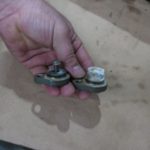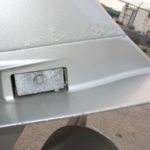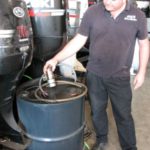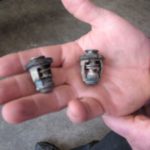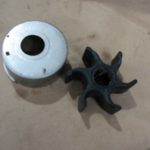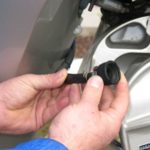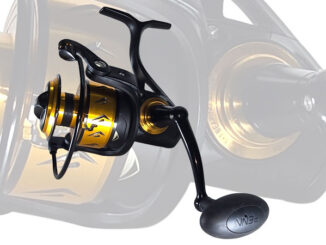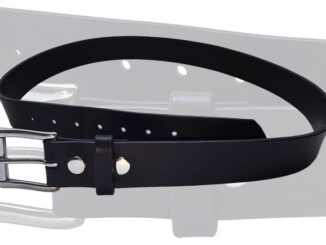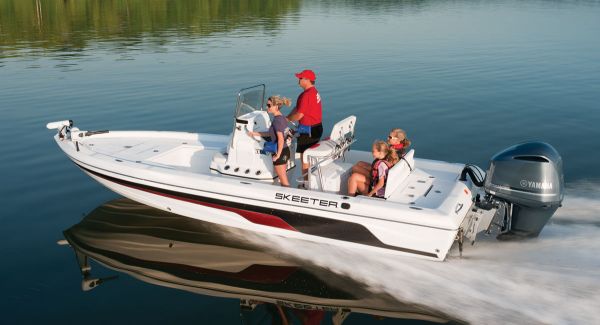
A four-stroke is designed to provide hundreds of hours of service, but they do require some TLC. Here are some simple ways to get the most out of your outboard.
The advent of the four-stroke outboard has changed a lot about boating. No more oil-and-gas mixtures, less pollution, better economy overall and generally lower maintenance.
A well-maintained four-stroke engine can give its owner 4,000 hours of service or more without major issues. When you consider that the average boater will put 50 hours a year or less on his outboard, you realize these engines should outlive you.
But a common mistake some anglers are making is confusing low maintenance for no maintenance — and engine problems or even catastrophic engine failure can be the result.
Expert outboard mechanic Gabe Dominique, owner of Advanced Marine & Machine (504-458-0076) in Kenner, said our four-stroke engines actually require some additional attention besides the usual annual oil changes and thermostat/water pump service, to keep them running at their peak and to insure a long life of service.
With fishing season really kicking in this month, this is the perfect time to service your four-stroke to ensure a trouble-free season.
So Dominique shared his four absolute essentials for four-stroke maintenance.
1. Service the anodes
“This is critical to the life of your engine,” Dominique said. “A four-stroke operates at much higher temperatures than the old two-strokes, which can make them more prone to corrosion if you don’t keep the internal anodes serviced.”
The external anodes are just as important.
“In our area, most anglers operate in salty or brackish water, so the external anodes are also critical,” he said. “Anodes are a sacrificial metal fitted to the bottom of the power trim bracket and on the lower unit — either a rectangular bar or the correction tab — to keep corrosion from attacking the engine itself. If they become covered with corrosion and you don’t clean or replace them, the galvanic corrosion will attack your lower unit and eat it away.
“This can happen very fast, so it is essential to service and clean the external and internal anodes every year.”
And it’s easy to make sure the anodes are ready to perform.
“Take them off, wire-brush or sandpaper them to expose fresh metal to the environment,” Dominique said. “If 30 to 35 percent or more is eaten away, replace them.”
Once the external anodes have been given attention, it’s time to pull the cowling.
“Every outboard has internal anodes as well, some as few as two, others have six or seven. These protect your engine block, heads and exhaust manifold from corrosion — and they are all too often neglected,” Dominique said. “I cannot over-stress how essential it is to the life of your outboard to inspect and service these anodes at least yearly.
“Many of the engine failures I’ve witnessed have been due to their neglect. Once they’re covered with corrosion, they’re useless and the corrosion will attack your cylinders, eat away the metal and gaskets, and cause engine failure. Take them off, clean and replace if necessary, or have your service professional maintain them.”
And whatever you do, don’t paint over any of the anodes.
“That renders them absolutely useless and the corrosion will attack your outboard,” Dominique said.
2. Use clean, fresh fuel
“Fuel is a major issue among boaters for several reasons,” Dominique said. “Most boaters don’t realize that gasoline degrades. Octane levels will degrade by as much as 2 points and even more if it sits in the tank for months at a time, especially during the warmer months.”
That is a major issue, especially when using low-octane gasoline.
“Most engines today are engineered to run decently on 87 octane,” Dominique said. “But if that 87 octane degrades 2 points from sitting, you now have 84 to 85 octane, which your boat is not engineered to run on.”
Four-strokes have to be fueled by gasoline reaching at least that 87-octane threshold.
“Most four-strokes will have anywhere from 170 to 220 PSI of compression, compared to the old two-strokes that ran on 120-130 PSI,” he said. “These are high-compression, high-performance and high tech-engines that must have 87 octane, at the very minimum.
“Less (octane) can cause a major problem with pre-ignition and detonation within the cylinders, causing loss of power and pistons to rattle, crack and fail.”
He said the habits of many anglers can just ruin an engine.
“What habits? First, the fact that it isn’t uncommon for a boat to sit idle for months at a time,” Dominique said. “The fuel degrades in the tank like the fizz disappears from a can of soda when it sits. But if the fizz in soda dissipates, all you get is a flat taste.
“If octane dissipates, it can ruin your engine.”
And owners sometimes make the situation worse by trying for an easy fix.
“They crank up the engine after months of sitting up, and when it runs poorly from lack of octane, they crank it wide open thinking that will ‘clean it out,’” Dominique said. “Then they hear a pop from the engine and experience a dramatic loss of power.
“Why? They cracked a piston, running hard on gas without enough octane.”
For boats that have been idle for a while, there are a couple of approaches he recommended.
“You can avoid an expensive repair bill if you keep the RPMs at 2,000 to 3000 and burn off as much of the old gas as possible,” Dominique said. “Or you can add octane to your gas two ways: Buy a higher grade of gasoline to begin with — at least 89 or more — so if it sits a while and degrades a couple points you’ll still have 87 when you run it.
“Or add octane booster to your fuel tank. If you increase the octane, you reduce the possibility of pre-ignition and detonation.”
But really, Dominique said, you should seriously consider replacing old fuel with fresh gas for yet another reason.
“Water in the tank,” he said. “Every boat has an open-fuel-tank vent system, and that vent is almost like leaving the cap off your gas can. Moisture will get in, especially if your boat is kept outside or even under a carport.
“Add to that the problems outboards have with ethanol, which is a water attractant, and your problems multiply.”
And that brings up another issue.
“Ethanol is bad news for outboard motors,” Dominique said. “It eats fuel lines, corrodes aluminum gas tanks and attracts moisture, so I advise you to avoid using it if at all possible because it definitely will increase your maintenance bill.”
Dominique does recommend adding a marine fuel stabilizer, such as Sta-bil, to your tank, and he said to get rid of gasoline if it’s six months old or older.
“If you can safely do it, pump it into your car or truck gas tank,” he said. “Your vehicle will only turn 2,000 to 3,000 RPMs and can safely use it up. Or you can bring your boat to the repair shop and have them drain the tank.
“Keep in mind, your four-stroke engine is running at 4,000 to 5,000 RPMs, like a race engine, and top-notch fuel is essential for its proper performance and longevity.”
He said there are two steps to take that would help prevent problems with bad fuel.
“It would be better not to fill your tank up after a fishing trip,” Dominique said. “I know that’s what you’ve probably been told to do to reduce moisture from gathering in your tank, etc. However, the opposite is true. Moisture will gather either way, on a full or half full tank.
“It’s far better to go home after a fishing trip and fill up with fresh gas on the morning of your next trip. That ensures you’ll get fresh fuel and higher-octane mixed in with the older gas, and your engine will run better and last longer.
“I see way more engine failures due to octane problems than due to moisture problems.
Secondly is a simple addition to the fuel system.
“Be sure your boat has a Raycor-Parker aqua-block water separator filter,” he said. “There may be other brands equally good, but I know this brand well and I use it and recommend it.
“If your boat isn’t equipped with one have one added to your fuel line ASAP.”
3. Service the water pump and thermostat
“This is another critical maintenance issue in outboard motors, and even more critical for four-stroke engines because they run at such high temperatures and high compression,” Dominique said. “Most boaters are aware of how important the water impeller is. We advise they be serviced annually and changed at least every other year.”
But how you use a boat also dictates how often an impeller should be changed.
“It’s critical that your service provider knows if your boat sits without use for five or six months at a time, or if you run your motor in a lot of sandy or muddy water so the best replacement schedule of your water pump impeller can be determined,” he said. “The sandy or muddy water can eat up an impeller, and letting it sit up bends several of the vanes and can cause them to stay bent permanently, causing overheating.
“And some outboards have short-vane impellors, which should automatically be changed yearly. Check with your service provider if you are uncertain which type of impeller your engine uses.”
You might be able to stretch this maintenance schedule a bit with two-stroke outboards, but Dominique said it’s a different ball game with four-strokes.
“I used to hear people boast that they went five or six years without changing the impeller on their two-stroke engines,” he said. “Don’t try that on your four-stroke.”
Having the thermostat on the checklist also is important.
“The thermostat allows the engine block to heat up and expand equivalent to that of the piston (expansion), and in these high-compression four-stroke engines that is critical,” Dominique said. “If the thermostat gets stuck closed, your alarm will sound so you can shut down without damaging the motor.
“But if it gets stuck open, the block doesn’t expand but the piston does, and you can imagine what happens when the piston becomes larger than the cylinder: The engine will seize.
“We used to sometimes remove the thermostats from our old cars because it wasn’t that critical. But you can’t do that with these outboards. It is essential that you have a properly functioning thermostat, so it should be checked every year and changed at least every other year.
4. Flush out your outboard
Dominique said flushing your engine after any saltwater use is absolutely essential to its longevity.
“Most of the four-stroke engine failures I see is on motors with a lot of corrosion,” he said. “Motors that weren’t flushed are going to have salt buildup and corrosion.
“Plus, if you run in muddy water or chew up the bottom in shallow water, then liquefied mud and dirt gets sucked into the engine — where it will solidify and harden if not flushed out. Then those hardened pieces can later break off as a solid and do damage to your engine.”
Taking care of this piece of business is easy.
“Nowadays the manufacturers all put a garden-hose flush port on the engine, so you can just screw your garden hose right to it and flush the motor without even having to start it,” Dominique said. “Run the hose for 10 to 15 minutes to flush out all the salt and dirt and mud, and you’re done.
“If you choose to start the engine while flushing it, let it run at idle when using the flush port. If you want to rev your engine up while flushing it, you’ll want to attach it to a set of rabbit ears.”
Dominique said boats that hang on a sling usually go un-flushed because of the difficulty reaching the port or water intakes on the lower unit.
“That’s easy to remedy,” he said. “Have your service professional reroute the flush port for you so you can reach it from inside the boat: a cheap, quick fix that’ll add years to the life of your outboard motor.”

